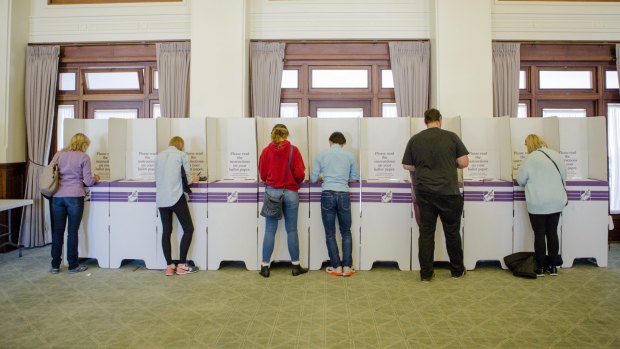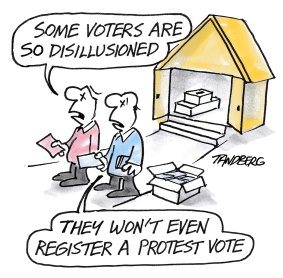By Nicole Hasham
A long winter federal election campaign that clashed with school holidays has resulted in the biggest voter no-show since compulsory voting began in 1925.
More than 1.4 million Australians last month failed to cast a vote for the House of Representatives in what ultimately became a cliff-hanger election. The figure represents more than 9 per cent of 15.7 million eligible voters.
The turnout is the worst since 1922, when voting was optional and just 59 per cent of eligible people cast a lower house vote.
Compulsory voting was introduced before the 1925 federal election.

Two voters appear to have voted early and voted often after they were marked off the electoral roll 11 times. Credit: Jamila Toderas
Voter turnout is calculated by dividing the sum of formal and informal votes by the final enrolment figure.
In the Senate contest last month, 8.1 per cent of people failed to vote – a slightly better result than that for the lower house.
An Australian Electoral Commission spokesman said the discrepancy came about because some people casting absentee votes wrongly identified the electorate they were enrolled in.
While their lower house votes would not have been counted, their Senate votes would have been valid, as long as they submitted a ballot paper for the correct state.

ABC political analyst Antony Green.Credit: Jacky Ghossein
After each election, the AEC asks all apparent non-voters to provide a sufficient reason or pay a $20 penalty. If the fine is not paid and no reason is given, the matter may be referred to a court and those found guilty can be fined up to $180 plus court costs.
The AEC on Monday announced it had returned the writs for the 2016 election.

Illustration: Ron Tandberg.
The rare winter federal poll, the culmination of a record-long eight-week campaign, coincided with school holidays in almost every state.
An AEC spokesman said it made a concerted effort before the 2016 election to boost enrolment figures, including directly enrolling people based on information from other government agencies such as Centrelink.
It meant 95 per cent of Australians aged 18 and over were on the electoral roll, up from 92 per cent in 2013.
ABC election analyst Antony Green said this increase may have contributed to the lower voter turnout, because "you end up enrolling people who tried to avoid voting for years".
Mr Green said even if all eligible voters cast a ballot last month, the overall result probably would not have been different because "they wouldn't all vote one way".
New Senate voting rules at last month's poll meant voters were required to either number at least six boxes above the line, or at least 12 boxes below the line.
There was criticism after the election that voters were confused about the changes, which could have affected the outcome of tight contests.
Mr Green said the informal vote rate in the Senate – 3.94 per cent – was only slightly higher than at the last election, suggesting the vast majority of people complied with the new rules.
The AEC spokesman said it "ran a really extensive campaign" to encourage voter turnout and explain the new Senate voting rules, adding there was a "a broad range of influences as to why people vote or don't vote".